 |
| Eliot Noyes served as Consultant Director of Design for IBM from 1954 -1977 Photo: courtesy of the Eliot Noyes Family |
Jason Cohn’s Modernism, Inc.: The Eliot Noyes Design Story (produced by Camille Servan-Schreiber) takes us into the extraordinary world of an architect and industrial designer whose associates included Bauhaus founder Walter Gropius, Mies van der Rohe, Marcel Breuer, Eero Saarinen, the esteemed graphic/film title designer and Oscar-winning filmmaker Saul Bass, Philip Johnson, Charles and Ray Eames. Eliot Noyes, who, among many other accomplishments, reinvented the image of IBM and gave the world the river rock-shaped first electric typewriter, the Selectric, is called “the design conscience of mid-century American industrial giants.”
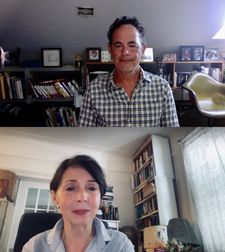 |
| Jason Cohn with Anne-Katrin Titze on Eliot Noyes and his projects: “He needed to bring in the best architects from all over the world, Marcel Breuer, Mies van der Rohe, Eero Saarinen …” |
Starting with his education at Harvard to his careers at New York’s Museum of Modern Art and the Pentagon, from how Noyes as Consulting Director of Design at IBM influenced every aspect of the company to his collaborations with the best designers in their fields, from the big red O in the Mobil Oil gas stations to being the president of the Aspen Design Conference - Modernism, Inc.: The Eliot Noyes Design Story is filled with information and inspiration that elegantly carries over from the last century into this one.
From San Francisco, Jason Cohn joined me on Zoom for an in-depth conversation on Modernism, Inc.: The Eliot Noyes Design Story.
Jason Cohn: Hi! Nice to meet you.
Anne-Katrin Titze: Nice to meet you, too. You escaped LA right before the earthquake?
JC: No, actually I was there. But I was in my car, as you know, because in Los Angeles you're always in your car. So I didn't feel it.
AKT: Good thing!
JC: They said it was surprisingly strong because it was centered right there in the middle of the city.
AKT: We had one here in New York in April, and I was on the subway, so I felt nothing. Everyone else felt a big shaking.
JC: It's very unusual to have earthquakes in New York.
AKT: Yes, very much so. It was 4.8, I think. It was pretty strong and I missed it.
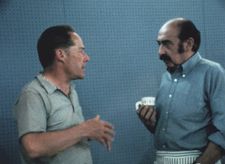 |
| Eliot Noyes with graphic designer Saul Bass at the Aspen Conference in 1970 Photo: film IDCA 1970; courtesy of Eli Noyes |
JC: Of natural disasters that you can experience, earthquakes are by far the best.
AKT: Tell me why!
JC: First of all, there's no dread, you know, like with a hurricane or something where you're waiting for it to hit you. And there's the news reports coming in. So you don't have any of that, it just suddenly happens, and you almost don't have time to be scared. You look around and it's just amazing, you know, like the walls are shaking. It's beautiful. We had a couple of really big ones here. And it's really cool the way neighbours gather around. You know, it's like a moment you feel really part of a community. It's fun. We're all waiting for the big one where California joins Hawaii, and that won't be fun.
AKT: That's what I was thinking about; anticipation is in the air and has been for a while for that one. Let's talk about Eliot Noyes! You start with images of his great typewriter, and then a woman in a lovely dress comes in and sits in a great chair, and she has perfect nails and she types: “Why should we care about Eliot Noyes?” And I think with the imagery already you gave one of the answers. Great start!
JC: Thank you! That’s my wife [Camille Servan-Schreiber], by the way! She’s a producer of the film.
 |
| Eliot Noyes ran the Pentagon’s glider program during the Second World War Photo: courtesy of the Eliot Noyes Family |
AKT: Oh, did she produce a film many years ago about art looted by the Nazis?
JC: Yeah! She was one of the producers.
AKT: That’s a fabulous documentary! It was great, very informative. The Rape Of Europa, I think it was called.
JC: Based on a book [The Rape Of Europa: The Fate Of Europe's Treasures In The Third Reich And The Second World War by Lynn H Nicholas], yeah. I'll tell her you liked it.
AKT: Please do! In Modernism Inc., you bring us to Astor Place in the present, where IBM headquarters are located now. Reflected in their new building, which is something I love whenever I walk across the square, you see the old Wanamaker Department Store that was built in the 1890s. It's a beautiful connection to what Noyes did, updating for new contexts. Was IBM helpful giving you archival material?
JC: Yes! I felt that the IBM work was the crux of his story. I thought it was the most important part of his story. He did a lot of work for other companies that we don't really even touch on. We barely talk about anything he did for Westinghouse. He did a lot of work for this Company Cummins Engines in Indiana. He did some work for Xerox, for Pan Am.
 |
| A view of Eliot Noyes’ Aerospace Building designed for IBM in Los Angeles Photo: courtesy of IBM |
But to me, where he really developed his ideas and the company that really allowed him to pioneer this new way of thinking about design within a corporation, it was IBM. That’s where he built his reputation and his stature in the design community. So yeah, we focused on the IBM story and they were hugely helpful with the archives. They really care about their history, and they do a great job of maintaining all of their materials and their records, and they're very helpful when researchers and filmmakers, and other people want access to stuff.
AKT: What about Harvard? Noyes was “a disgruntled architecture student at Harvard,” as someone calls him in the film. Did you go to these archives as well? The connection with Gropius is fascinating.
JC: Yeah, it was a little bit difficult, because most of the work was done during the pandemic and the Harvard archive was closed. The Noyes archive itself is moving to Harvard. Harvard has acquired it but it's still in a transitional phase. So, fortunately for me, the materials were still in New Canaan and Eliot's family had access to it, so I was able to spend a lot of time with the Eliot Noyes archives before it went to Harvard. But yeah, I tried to get into the Harvard archives to see if there were images of him with Gropius for example, and I wasn't really able to do that at that time.
 |
| Eliot Noyes rebranded Mobil Oil for a new era Photo: courtesy of the Eliot Noyes Family |
AKT: Noyes had a fascinating life. Right after Harvard he became MoMA’s director of Industrial Design. He had his big furniture exhibit! But the year is 1940, and the war breaks out, and new furniture is not on people's minds anymore for the time being. Were you surprised by all of these twists and turns when you were looking at his life?
JC: Yeah, they made it hard to tell a story in some ways. And I'll tell you another one which didn't make it into the film. I originally edited it into the film but I just found it was too twisty and turny and hard to follow, so I had to take the story out. But I love telling the story. So he went to Harvard and was unhappy there, right? And at that moment, this delegation of archeologists from the University of Chicago passed through Harvard because they were taking a ship to Persepolis in Persia, modern day Iran, to excavate the site of Persepolis, King Darius, it’s a great archeological site, and they were looking for someone to draw paintings. They wanted someone to actually draw what they were taking out of the ground with watercolours.
So this delegation of University of Chicago archeologists comes through Harvard and they’re asking for somebody who’s really excellent at drawing. And everybody said, our best draughtsman is Eliot Noyes. He actually wanted to study fine art before he switched to architecture. So they said, would you like to go to Iran, to Persia, to help us with this excavation?
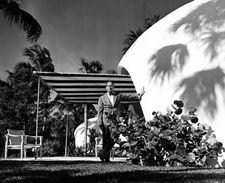 |
| Eliot Noyes with one of his 'Bubble Houses', completed in 1954 in Hobe Sounds, Florida Photo: courtesy of the Eliot Noyes Family |
He says yes, two days later he had dropped out of Harvard, was on a ship headed to the Middle East, and he spent the next two years basically working with this archeological team. There’s beautiful drawings that he did of these tablets and things they were taking out of the ground in Iran. That was actually where he learned how to fly gliders.
AKT: Wow, that explains a lot!
JC: Because they would fly over the archeological site and they would look for undulations in the earth because that would be an indication of where there might be things under the ground. When he was bored, he would get glider lessons from the glider pilot and that’s how he became an expert glider pilot.
AKT: The glider story is totally fascinating. That he signed up for the Air Force and was the head of the glider program now all perfectly makes sense. Then comes this wonderful, wonderful story about how he got the glider program more attention! How he got the officers at the Pentagon to take notice of the gliders by contacting the creator of the comic strip [Milton Caniff’s Terry and the Pirates] that they were reading every morning!
JC: The reason I like that story is because it showed his incipient management skills, right? When you're a manager, you have to be able to manage down. But you also have to be able to manage up. You need to be able to manage the people above you. That shows how creative he was in terms of managing the people above him. There’s probably elements of that in his relationship with [IBM’s] Tom Watson for example. He knew that he couldn’t tell the people what to do. He had to find ways of making them interested in the things that he was interested in, and I think he was very, very clever and creative with that kind of thing.
 |
| IBM HQ at Astor Place in New York Photo: Anne Katrin Titze |
AKT: And it happened through a comic strip! I love that you show that letter to the creator! After the war, he is settling down in New Canaan, and his ideas, as always, since the initial Bauhaus interest, are connected to his interest in social changes. Changes in the world also always have to be reflected in the design. Social changes - no more upstairs-downstairs with servants - and changes in available materials influence the new designs.
JC: I think that people sometimes have a mistaken idea of what Modernism is. They tend to think of it as a fixed aesthetic. I don't think that's at all the way that Eliot Noyes saw Modernism. He saw it as the desire constantly to be looking for the best of what’s available.
And so that meant staying acutely attuned to what was being developed technologically, in terms of materials, in terms of techniques, aesthetics as well. You don’t want to always be looking for gimmicky decorative tricks, but if there's new materials available, and they're useful for certain applications, you want to be on the cutting edge with how those are used. And I think that's what he was always doing.
AKT: Battles with nature, with warmth, are not the necessary central point for buildings anymore and so the windows, the size of rooms can grow with new technologies available. The connection to nature is important: The river rock comparison for the Selectric, a typewriter that actually looks like a river rock for example! Noyes must have had a very strong connection to nature.
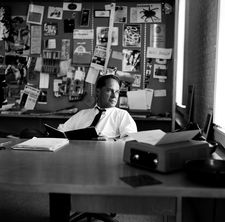 |
| Eliot Noyes at work in his New Canaan Office Photo: courtesy of the Pedro Guerrero Estate |
JC: Yes, I think he did. He was an avid skier, quite an outdoorsman and with his own home, he really wanted it to feel like it was part of nature, and I think he did a really remarkable job of building a house that inculcated that idea and inculcated a love of nature in all of his children, who all feel a very strong connection to nature. The remarkable thing of making a house where you have to go outside to go to the bathroom! It’s great.
AKT: There's a sense of humor in it and again a connection, a mirroring, and updating of the past in a way. The outhouse people used to have. So now it's inside but you still have to go outside in order to get to it. He should also get credit for that sense of humor you could see in many of his things.
JC: Yeah, absolutely. Rebelliousness, in any case. He wasn't going to do something just because it was the way that everybody did. He followed his own star, for sure.
AKT: The parlor and coal cellar concept episode is also quite fascinating. He learned from his failures. His love of showing how everything works could backfire and you can show too much. You create fear, the opposite effect.
JC: It's just so obvious. And we completely take it for granted that computer designs would be done in such a way that all of the complicated stuff that we don't need to interact with as computer operators, all of that stuff would be hidden away. But that's not the way it was at all. The early computer models, like everything was all over the place, and it was all visible.
 |
| During Noyes’ time with IBM, he helped revolutionise the design of computers. Photo: courtesy of IBM |
Of course, it was a collaboration with the engineers, because that stuff had to be sort of sequestered. A ton of research and a lot of work had to be done to figure out to make the parts that people do need to interact with, to have those put in a way that are ergonomically and visually intuitive.
It was a breakthrough to think about the computer in that way. And I think it was very far thinking, because, you know, at the time, people like you and me had nothing to do with computers. Computers were for highly trained technicians, so it was fine to have all of the wires and the openings, and to have it all visible because the people who were using it knew what was what and they needed access to all of that stuff, right?
But he was thinking about a time when it would be people like you and me, writers, accountants, airline reservations operators who would be using these things. So he was thinking about, how do I make this in a way that those people are going to be able to sit down and instantly understand what to do? It was a big break.
AKT: He did incredible thinking on his feet throughout his life, which went with his diplomacy skills that you point out. He was also hiring Charles and Ray Eames for communication with the IBM consumers. Tell me more about that! I think you know a little bit about the Eameses!
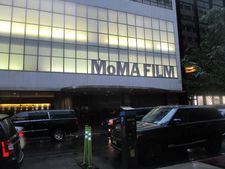 |
| Eliot Noyes was the Director of Industrial Design at the Museum of Modern Art in New York Photo: Anne Katrin Titze |
JC: Yes, I made a film about them. Well, I think first of all, the thing that it reveals most about Eliot Noyes is his understanding of himself in his own abilities, his own limitations and his kind of humility. But he knew what he was good at and he knew what he was not good at. He was smart enough to understand that there were people who are really good at certain things that he could bring in and work with. He was very generous in terms of sharing the limelight and sharing the credit. He was very happy, I think, to be behind the scenes at IBM sort of pulling the strings.
I think of him as kind of like an orchestra conductor who was very happy to have Charles and Ray be first violin for this project and then, you know, an architect like Mies van der Rohe be first violin for that project. And he is behind the scenes or waving the baton. He didn't need all of the credit, but in the end, he’s the indispensable person who knows who is good at doing each task and he’s able to bring them in, allow them to work at their best and share the credit.
In fact, in most cases not really get much credit. He was that in-between person. Tom Watson has a problem, he knew who could help solve that problem. He figured out how to put the brief together so that the architects or the designers understood what needed to be done, and then he was able to kind of marshal the resources and direct the project in such a way that it got done.
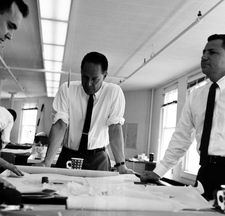 |
| Jason Cohn on Eliot Noyes: “He’s the indispensable person who knows who is good at doing each task … Photo: courtesy of the Pedro Guerrero Estate |
It was just that the amount of work that was being done at IBM was so extraordinary large. There's no way he could have, or his office could have done it all themselves. He needed to bring in people like Charles and Ray Eames. He needed to bring in the best architects from all over the world, Marcel Breuer, Mies van der Rohe, Eero Saarinen, all these incredible architects. But he was the person who was managing it all and making sure that it was all of the highest quality.
AKT: And always what society was in need of. I think that's what answers the question that you start out with, why should we know Eliot Noyes? Why should we care about him? That's why. This doesn't stop with him. There's a method to what he did, I think, And that is very much something that we need right now, union of beauty and utility for the now and our problems now.
JC: Yes. I agree!
AKT: Thank you for this film!
JC: Very nice meeting you! Take care!





















